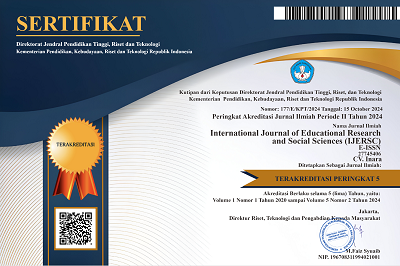Submissions
Submission Preparation Checklist
As part of the submission process, authors are required to check off their submission's compliance with all of the following items, and submissions may be returned to authors that do not adhere to these guidelines.- The submission has not been previously published, nor is it before another journal for consideration (or an explanation has been provided in Comments to the Editor).
- The submission file is in OpenOffice, Microsoft Word, or RTF document file format.
- Where available, URLs for the references have been provided.
- The text is single-spaced; uses a 12-point font; employs italics, rather than underlining (except with URL addresses); and all illustrations, figures, and tables are placed within the text at the appropriate points, rather than at the end.
- The text adheres to the stylistic and bibliographic requirements outlined in the Author Guidelines.
Articles
Section default policy
Copyright Notice
COPYRIGHT
Authors retain copyright and grant the journal the right of first publication with the work simultaneously licensed under a Creative Commons Attribution-NonCommercial 4.0 International License. that allows others to share the work with an acknowledgment of the work's authorship and initial publication in this journal.
Authors are able to enter into separate, additional contractual arrangements for the non-exclusive distribution of the journal's published version of the work (e.g., post it to an institutional repository or publish it in a book), with an acknowledgment of its initial publication in this journal.
Authors are permitted and encouraged to post their work online (e.g., in institutional repositories or on their website) prior to and during the submission process, as it can lead to productive exchanges, as well as earlier and greater citation of published work (See The Effect of Open Access).
LICENSE TO PUBLISH
1. License
The non-commercial use of the article will be governed by the Creative Commons license as currently displayed on Creative Commons Attribution-NonCommercial 4.0 International License.
2. Author’s Warranties
The author warrants that the article is original, written by stated author/s, has not been published before, contains no unlawful statements, does not infringe the rights of others, is subject to copyright that is vested exclusively in the author and free of any third party rights, and that any necessary written permissions to quote from other sources have been obtained by the author/s.
3. User Rights
Under the Creative Commons Attribution-NonCommercial 4.0 International License, users are free to share (copy, distribute and transmit the contribution).
4. Rights of Authors
Authors retain the following rights:
a. copyright, and other proprietary rights relating to the article, such as patent rights,
b. the right to use the substance of the article in future own works, including lectures and books,
c. the right to reproduce the article for own purposes, provided the copies are not offered for sale,
d. the right to self-archive the article.
5. Co-Authorship
If the article was prepared jointly with other authors, the signatory of this form warrants that he/she has been authorized by all co-authors to sign this agreement on their behalf, and agrees to inform his/her co-authors of the terms of this agreement.
6. Termination
This agreement can be terminated by the author of "International Journal of Educational Research & Social Sciences (IJSERSC)" upon two months’ notice where the other party has materially breached this agreement and failed to remedy such breach within a month of being given the terminating party’s notice requesting such breach to be remedied. No breach or violation of this agreement will cause this agreement or any license granted in it to terminate automatically or affect the definition of "International Journal of Educational Research & Social Sciences (IJSERSC)".
7. Royalties
This agreement entitles the author to no royalties or other fees. To such extent as legally permissible, the author waives his or her right to collect royalties relative to the article in respect of any use of the article by "International Journal of Educational Research & Social Sciences (IJSERSC)" or its sublicensee.
8. Miscellaneous
"International Journal of Educational Research & Social Sciences (IJSERSC)" will publish the article (or have it published) in the Journal if the article’s editorial process is successfully completed and "International Journal of Educational Research & Social Sciences (IJSERSC)" or its sublicensee has become obligated to have the article published. "International Journal of Educational Research & Social Sciences (IJSERSC)" may conform the article to a style of punctuation, spelling, capitalization, and usage that it deems appropriate. The author acknowledges that the article may be published so that it will be publicly accessible and such access will be free of charge for the readers. "International Journal of Educational Research & Social Sciences (IJSERSC)" will be allowed to sublicense the rights that are licensed to it under this agreement.
Privacy Statement
The names and email addresses entered in this journal site will be used exclusively for the stated purposes of this journal and will not be made available for any other purpose or to any other party.





